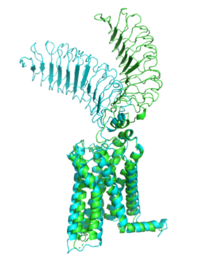Sandbox Reserved 1780
From Proteopedia
(Difference between revisions)
| Line 18: | Line 18: | ||
===TSH Agonist=== | ===TSH Agonist=== | ||
[[Image:NAG.png|200 px|left|thumb|Figure 3]] | [[Image:NAG.png|200 px|left|thumb|Figure 3]] | ||
| - | Thyroid-stimulating hormone (TSH) | + | Thyroid-stimulating hormone <scene name='95/952708/Tsh_7t9i/1'>(TSH)</scene> is a hormone that stimulates the thyroid gland to produce proteins that are vital for many metabolic pathways in the body's tissue. TSH activates the TSHR protein by binding to the concave surface of the LRRD and hinge region to keep TSHR in its active state by clashing with the membrane <ref name="Duan"> DOI:10.1038/s41586-022-05173-3</ref>. (Figure 2). This clash is caused by glycosylations of an asparagine 52 residue on the alpha subunit of TSH (GREEN LINK). These modifications to the ASN residue are N-acetyl glucosamine modifications (Figure 3). They stick out from the alpha subunit of TSH to clash with the cell membrane and keep TSH in the active state. |
Revision as of 20:09, 3 April 2023
| This Sandbox is Reserved from February 27 through August 31, 2023 for use in the course CH462 Biochemistry II taught by R. Jeremy Johnson at the Butler University, Indianapolis, USA. This reservation includes Sandbox Reserved 1765 through Sandbox Reserved 1795. |
To get started:
More help: Help:Editing |
| |||||||||||
References
- ↑ 1.0 1.1 1.2 1.3 Faust B, Billesbolle CB, Suomivuori CM, Singh I, Zhang K, Hoppe N, Pinto AFM, Diedrich JK, Muftuoglu Y, Szkudlinski MW, Saghatelian A, Dror RO, Cheng Y, Manglik A. Autoantibody mimicry of hormone action at the thyrotropin receptor. Nature. 2022 Aug 8. pii: 10.1038/s41586-022-05159-1. doi:, 10.1038/s41586-022-05159-1. PMID:35940205 doi:http://dx.doi.org/10.1038/s41586-022-05159-1
- ↑ Nunez Miguel R, Sanders J, Chirgadze DY, Furmaniak J, Rees Smith B. Thyroid stimulating autoantibody M22 mimics TSH binding to the TSH receptor leucine rich domain: a comparative structural study of protein-protein interactions. J Mol Endocrinol. 2009 May;42(5):381-95. Epub 2009 Feb 16. PMID:19221175 doi:10.1677/JME-08-0152
- ↑ 3.0 3.1 doi: https://dx.doi.org/10.1210/en.2006-1754
- ↑ Duan J, Xu P, Luan X, Ji Y, He X, Song N, Yuan Q, Jin Y, Cheng X, Jiang H, Zheng J, Zhang S, Jiang Y, Xu HE. Hormone- and antibody-mediated activation of the thyrotropin receptor. Nature. 2022 Aug 8. pii: 10.1038/s41586-022-05173-3. doi:, 10.1038/s41586-022-05173-3. PMID:35940204 doi:http://dx.doi.org/10.1038/s41586-022-05173-3



